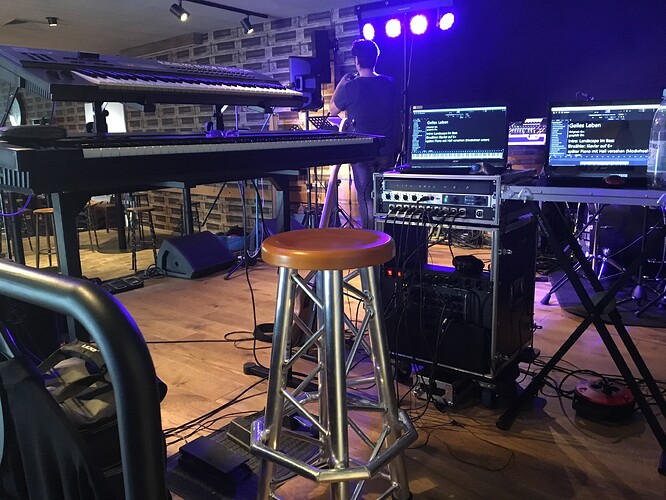OK, here some thoughts from my side:
I run a pure “in-the-box” setup - two MIDI keyboards (Kurzweil weighted 88 key and my custom 61 control keyboard) and one guitar into Cantabile, plus a VoiceLive Rack controlled by Cantabile via MIDI out. Sending 3 separate signals to the desk (keys, guitar, break music) - used to be three stereo pairs, but simplified that down to mono.
I found that having a second “fall-back” solution with my live keyboards’ on-board sounds would be too cumbersome - essentially, I’d have to build every setup twice.
So I currently rely on a fully duplicate Cantabile setup - I run my live rig on my “live cube” (a little ASRock system) and I always have a fully configured laptop with me that could run the same show as my main rig. I actually switch between both on a regular basis in rehearsals to make sure they’re live and well. So if I run into issues with my live PC, I boot up my live laptop and can be fully up and running in 2 minutes or so. Haven’t had to so far, but good to know I can.
I also have spares in my bag for the more sensitive components: spare MIDI interface, audio interface, in-ear pocket amp, etc, so that if something goes wrong, I can somehow make things work - even if that might mean that some things don’t work as nicely as in my normal setup, but at the very least, it’ll get me through the gig…
Plus, I actually carry a third keyboard (usually a 61 key spare) to gigs in case one of my main boards goes crazy - I actually had that happen to me during a gig, with my main KB going totally crazy, transposing back and forth and turning on the arpeggiator at random. In that case: good to have your keyboards connected with classic DIN MIDI connectors - simply plug in any other keyboard in its place and go on without having to reconfigure anything in Cantabile.
Since I play mostly pub / club gigs, I don’t see the need to have a fully redundant “hot-standby” setup (yet) - our audiences would be somewhat forgiving if we had to take a quick “technical break” to get things rolling again.
If I had to build in more resilience to PC failures, I would go for a complete “hot standby” system, with two PCs running the show in parallel (so both connected to my keyboards and guitar) and both connected to separate channels at the desk, so it’s just a matter of muting three inputs and unmuting three others. Or I might go to a system based on the iConnectivity PlayAudio12 - this is an interface that allows you to connect two PCs at the same time and switching automatically from one to the other in case of failure (it listens to a “pilot tone” from the first PC, when that disappears for any reason, it automatically switches to play the input from the second).
But of course, in that case the interface becomes the single point of failure, so I’d probably go for the safer route with two PCs and two interfaces and just hope the person at the desk catches on quickly enough…
The question is how far you let your paranoia take you in terms of redundancy - carrying a second PC / laptop is pretty reasonable, carrying a second audio or MIDI interface could already be considered paranoid, and carrying a third keyboard has some of my band members scratching their heads - but it would have saved me a lot of anguish in that gig when my master KB failed (had to play half of the gig just on my upper KB until someone could drive and bring a spare). We also usually bring a spare small form factor mixing desk to be able to continue a show in case our main breaks down - of course that would mean a bit of a setup break, but better than having to end the show… But does anyone really bring a spare drum set?
Essentially it’s all about your risk appetite - in case of running an “in-the-box” Cantabile setup, the most vulnerable part does seem to be the PC running Cantabile, so it’s definitely a good thing for your nerves to have a complete copy of your setup on a second machine, ready to whip out and plug in. Strongly recommended if you are serious about a live PC setup!
